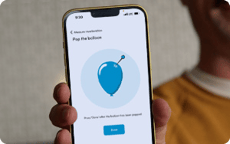9 lively hybrid learning activities that create a one-classroom feel

Posted by Tricia Whenham on Apr 14, 2021 6:00:00 AM
Years ago, when I was a first-year teacher fresh out of university, I received an invaluable piece of advice from my partner teacher: “Building your classroom community isn’t just a September activity. You’ll need to find ways to strengthen it every day.” Over the course of the year, I saw all the small things she did to keep her students connected. And how, one by one, they added up.
Creating a sense of community can be tricky in hybrid learning courses, where students joining remotely may feel disconnected from those who attend in person. But it is possible to develop a one-classroom feel. If you need some new ways to get everyone talking, here are 9 hybrid learning activities that can bridge the gap.
1. Full-class counting challenge
Challenge your class to count to 20, with one student at a time saying each number and going in no set order. If two students say a number at the same time, everyone starts again from the beginning. It’s surprisingly challenging and requires careful listening and patience from everyone. This activity can help students really tune into those who aren’t in the room with them. (Make sure that you have full-classroom audio coverage so everyone’s voice is always picked up.)
2. Would you rather?
The simplest questions can sometimes be the most fun. Would you rather be able to fly or turn invisible? Live in space or a submarine? Swim in a pool full of juice or chocolate pudding? With fun questions like these, students will be eager to share their take. And once you get them weighing the relative merits of unusual pets or jobs or snacks, that energy can carry over into the rest of the class. Here are 100 questions to try.
3. Movement breaks
In hybrid learning classrooms, scheduling regular times to get up and move is essential. We all know how exhausting it can be to sit in front of a screen all day. Plus, even in-person students may feel like they’re stuck at their desks too much. But movement breaks also give you an opportunity to bring students together. Try letting different individual students — remote and in person — lead everyone in their favorite exercise or silly action.
4. Quescussion
If you’d like to boost inquiry in your classroom while sparking more discussion, then quescussion might be for you. Think of it as a standard class discussion, but only questions are permitted. When someone makes a mistake, the class yells “Statement!” and the person needs to reword their point as a question. When done at the beginning of a unit or lesson, the questions raised get students more engaged in the topic. And when done at the end, everyone gets a sense of what has been learned and what’s still to be discovered.
5. Classroom debates
Debate is a time-tested way to get people talking. You can simply divide the class in two and assign sides or use a more structured debate format (here are a few to try). Debates are great for going deeper into the curriculum but work just as well for topics decidedly less serious. (If you want to see some passionate arguments, try asking “Is cereal a soup?”) It’s usually best to mix up the groups so remote and in-person students work together to formulate arguments, but make sure those in the room don’t dominate the conversation.
6. One-minute paper
How much could you explain in one minute? At the end of class, set a timer (for one minute or more) and ask students to record their most eye-opening revelations or something that still doesn’t make sense to them. Here are a few questions to get them started. Then students can share their one-minute papers with the class. Hearing that others have similar questions or struggles helps students see they’re not alone, plus it gives teachers a window into common misunderstandings or concerns.
7. Collaborative storytelling
This mainstay of summer camps and road trips can come in handy when trying to get students talking in your hybrid learning classroom. Basically, each student takes turn contributing a handful of words to a collaborative story — the results are almost always weird or funny and sometimes surprisingly effective. Make sure the storyteller alternates between in-person and remote students to keep up the energy on both sides of the screen and create the feeling that the whole class truly worked together on one story.
8. Student-led Jeopardy
Student-led Jeopardy, where learners come up with the answers and questions, is a great way to bring excitement to end-of-unit review. And the process of constructing the game itself also helps strengthen understanding. Make sure you set some ground rules on what topics will be covered and create teams with a mixture of online and in-person students. If you need help with a Jeopardy board that works online, here are a few options.
9. Quotable learning highlights
Bringing up students’ passions is a surefire way to get them talking, and this activity taps into that enthusiasm. Students take a concept from class and choose something from outside of school that they feel relates to it. It could be a famous quote, a song lyric, an image, a meme or anything else that they’d like to share, just as long as they can explain what the connection is. Be sure to leave enough time for students to piggyback on the idea with their own ideas or questions.
We’re in this together
These activities are just one way to keep students connected in a hybrid learning classroom. Breakout rooms in your UC&C software are also helpful to give students more of a chance to talk in smaller groups. And asynchronous collaboration activities — using the Google Docs™ platform or other online tools — can get students connecting in less obvious ways.
But there’s something about having a whole-class discussion that can create a sense of togetherness from anywhere. And that can make a big difference in letting students know that no matter how far apart we are, we’re still in this together.
Flexible tools for exceptional learning
Discover the easiest and most cost-effective way to equip your classrooms for engaged hybrid learning. Nureva® audio systems ensure that voices are picked up in every inch of the classroom — with no need for expensive multicomponent setups.
Editor’s note: This post was originally published April 2021 and has been updated.

Posted by
Tricia Whenham
April 14, 2021
















